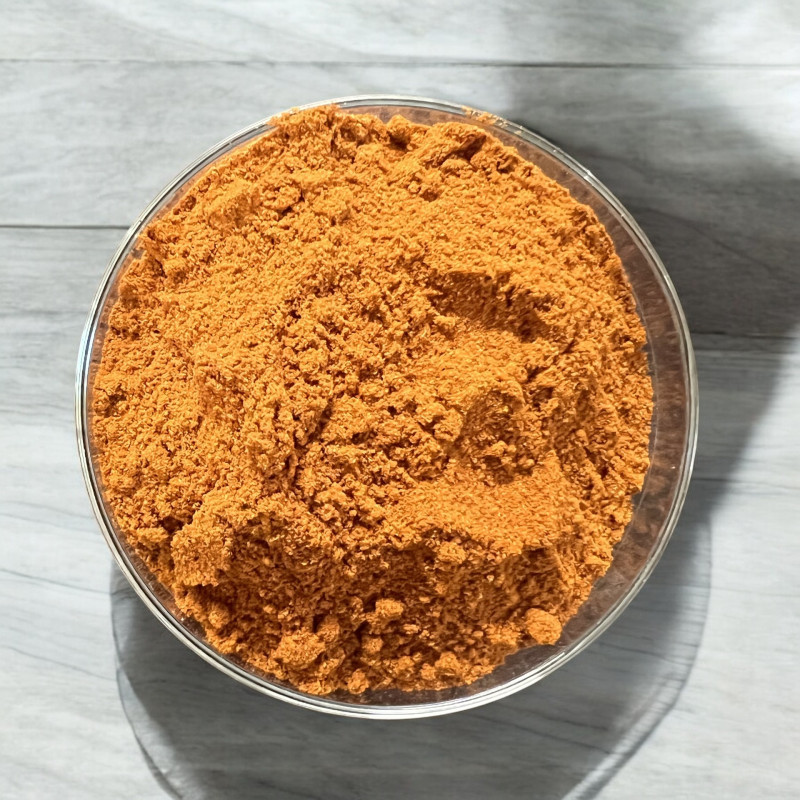
Reference: 20813701


It’s absolutely fiery, but that’s precisely its appeal!
Use it in small amounts to spice up any dish, especially ratatouille, calamari, shellfish, paellas, and many sauces.
 Delivery
Delivery
Mondial Relay
 Returns
Returns
See conditions
 Payments
Payments
100% secure
Livré en sachet refermable
Culinary Uses:
Ground Cayenne pepper is simply fiery! It adds an inimitable “pep” to nearly all savory dishes, and even to some sweet treats, as adventurous chefs have started using it in chocolate! However, use it with moderation.
It enhances ratatouille, calamari and shellfish dishes, paella, couscous, and many other recipes. Always use a moderate dose, unless you enjoy intensely spicy foods!
When whole, it’s essential for making spicy oils, often sprinkled on pizza but also used to start cooking various dishes, adding heat without overwhelming spiciness. In its powdered form, as here, it can be added to a wide variety of dishes and exotic sauces to give them just the right kick. It’s found in curries, tandoori dishes, chili blends, ras el hanout, Caribbean and Reunion Island cuisine, and many more! It’s also the key ingredient in rouille and tartar sauces.
Who Am I?
Origin: India - China - Indonesia
Scientific Name: Capsicum annuum
Common Names: Cayenne pepper, pili pili
If Cayenne pepper is accidentally consumed, drinking water won’t help, as capsaicin, responsible for its heat, isn’t water-soluble. Instead, drink milk, as capsaicin binds to the milk protein casein, which helps alleviate the heat faster.
Cayenne pepper helps the body adapt to high temperatures, a fact well-known in tropical regions. However, avoid touching your eyes or mucous membranes after handling it without washing your hands carefully, as it can cause intense burning! Used in moderation, it has numerous health and digestive benefits. In the West, it’s primarily used externally (in rubs) to help relieve arthritis and joint pain.
It’s also believed to have significant bactericidal properties, and consuming it in hot climates can greatly reduce the risk of intestinal infections.
Like all peppers, Cayenne is part of the Solanaceae family (along with tomatoes and eggplants) and, like them, originates from Central and South America. Although it’s named after the city of Cayenne, it isn’t cultivated there! Instead, it’s been grown for centuries in tropical climates worldwide.
Interestingly, researchers have observed that peppers “defend” themselves by increasing their spiciness in areas with more predators (insects or parasitic fungi).
A Bit of History:
The Aztecs called it "chili," a name that remains in English and German. For over 9,000 years, it was known to indigenous people of equatorial America for its culinary and medicinal properties.
A companion of Christopher Columbus introduced the plant to Europeans after a journey intended for the Indies, which instead ended in the Caribbean. The plant quickly spread to equatorial regions globally and was widely adopted in Asia, the Middle East, and Africa.
Data sheet
Specific References
Reference: 20813701
Reference: 10707402
Reference: 12M6951701
Reference: 12M6951701
Reference: 508212501
Reference: paprika
Reference: pilipili
Reference: 10707402
Reference: paprikafumé
Reference: 10814501
Reference: 20813701

It’s absolutely fiery, but that’s precisely its appeal!
Use it in small amounts to spice up any dish, especially ratatouille, calamari, shellfish, paellas, and many sauces.